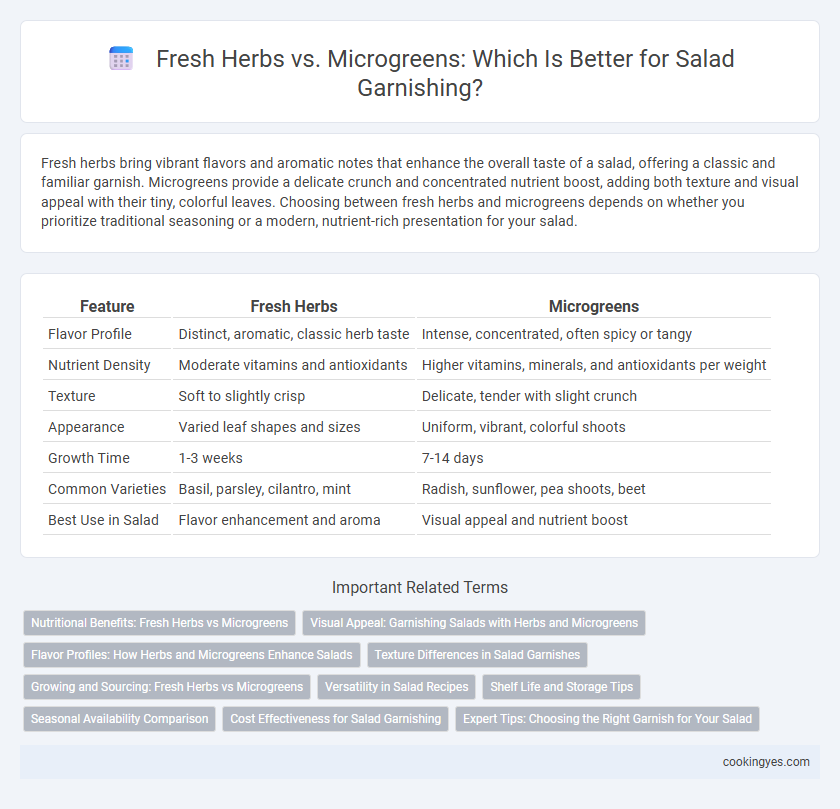Fresh herbs bring vibrant flavors and aromatic notes that enhance the overall taste of a salad, offering a classic and familiar garnish. Microgreens provide a delicate crunch and concentrated nutrient boost, adding both texture and visual appeal with their tiny, colorful leaves. Choosing between fresh herbs and microgreens depends on whether you prioritize traditional seasoning or a modern, nutrient-rich presentation for your salad.
Table of Comparison
| Feature | Fresh Herbs | Microgreens |
|---|---|---|
| Flavor Profile | Distinct, aromatic, classic herb taste | Intense, concentrated, often spicy or tangy |
| Nutrient Density | Moderate vitamins and antioxidants | Higher vitamins, minerals, and antioxidants per weight |
| Texture | Soft to slightly crisp | Delicate, tender with slight crunch |
| Appearance | Varied leaf shapes and sizes | Uniform, vibrant, colorful shoots |
| Growth Time | 1-3 weeks | 7-14 days |
| Common Varieties | Basil, parsley, cilantro, mint | Radish, sunflower, pea shoots, beet |
| Best Use in Salad | Flavor enhancement and aroma | Visual appeal and nutrient boost |
Nutritional Benefits: Fresh Herbs vs Microgreens
Fresh herbs such as parsley, basil, and cilantro deliver essential vitamins like A, C, and K along with antioxidants that support immune function and reduce inflammation. Microgreens, including varieties like arugula, sunflower, and radish, often contain higher concentrations of vitamins, minerals, and polyphenols per gram compared to mature herbs, boosting heart health and cellular repair. Selecting microgreens for salad garnish can significantly enhance nutrient density and flavor complexity, whereas fresh herbs provide traditional aromatic benefits with a moderate nutrient profile.
Visual Appeal: Garnishing Salads with Herbs and Microgreens
Fresh herbs like basil, parsley, and cilantro add vibrant, recognizable color and texture that enhance a salad's visual appeal with their familiar leafy forms. Microgreens, including pea shoots and radish sprouts, offer delicate, compact shapes and vivid hues that create an elegant, modern garnish effect. Combining both garnishes maximizes visual contrast and depth, elevating the overall presentation of any salad.
Flavor Profiles: How Herbs and Microgreens Enhance Salads
Fresh herbs such as basil, cilantro, and parsley offer robust, aromatic flavors that brighten salads with distinct herbal notes and subtle bitterness. Microgreens, including radish, arugula, and sunflower varieties, provide concentrated, intense flavors ranging from peppery to nutty, adding a dynamic taste complexity and visual appeal. Combining fresh herbs and microgreens in salads enhances flavor profiles by balancing boldness with delicate nuances, elevating both taste and texture.
Texture Differences in Salad Garnishes
Fresh herbs like parsley, basil, and cilantro provide a delicate, leafy texture that enhances salad complexity without overwhelming other ingredients. Microgreens, such as radish, arugula, and sunflower shoots, offer a tender yet crisp bite, adding a lively crunch and vibrant visual appeal to salads. The contrast in textures between soft fresh herbs and crisp microgreens creates a dynamic mouthfeel, elevating the overall salad experience.
Growing and Sourcing: Fresh Herbs vs Microgreens
Fresh herbs are typically grown in soil or pots with longer growth cycles, requiring more space and sunlight, making their sourcing often seasonal or regional. Microgreens are harvested just after the first true leaves develop, allowing for faster growth in controlled environments such as indoor farms or hydroponic systems, enabling year-round availability. Sourcing microgreens often ensures higher nutrient density and consistent freshness compared to traditionally grown fresh herbs.
Versatility in Salad Recipes
Fresh herbs like basil, parsley, and cilantro offer robust, easily recognizable flavors that complement a wide variety of salad bases from leafy greens to grains. Microgreens provide a vibrant visual appeal and concentrated nutrient density, enhancing flavor profiles with subtle textures and colorful accents. Both options expand versatility in salad recipes by allowing tailored gustatory experiences, from zesty and aromatic to mild and crisp, catering to diverse culinary preferences.
Shelf Life and Storage Tips
Fresh herbs like basil and parsley typically have a shelf life of about 5 to 7 days when stored in the refrigerator wrapped in a damp paper towel or in a glass of water. Microgreens, such as radish or sunflower greens, tend to last slightly shorter, around 3 to 5 days, and should be stored in airtight containers with a paper towel to absorb moisture and prevent wilting. For optimal freshness, keep both fresh herbs and microgreens away from direct moisture and ensure proper ventilation to extend their usability in salad garnishes.
Seasonal Availability Comparison
Fresh herbs such as basil, parsley, and cilantro are typically available seasonally, flourishing in warm months and often limited during colder seasons. Microgreens, including varieties like radish, sunflower, and pea shoots, can be grown year-round indoors under controlled conditions, ensuring consistent availability. This year-round cultivation advantage makes microgreens a more reliable garnish choice for salads regardless of seasonal fluctuations.
Cost Effectiveness for Salad Garnishing
Fresh herbs offer a cost-effective option for salad garnishing due to their availability and longer shelf life, reducing frequent purchases. Microgreens, while visually appealing and nutrient-dense, tend to be more expensive per ounce because of their intensive growing process and shorter lifespan. Considering budget constraints for salad garnishing, fresh herbs provide a more economical choice without compromising flavor and presentation.
Expert Tips: Choosing the Right Garnish for Your Salad
Fresh herbs like basil, cilantro, and parsley offer bold, aromatic flavors that enhance salad complexity, while microgreens provide a delicate texture and concentrated nutrient density ideal for visual appeal and subtle taste. Experts recommend selecting fresh herbs when seeking pronounced flavor profiles and using microgreens as a vibrant garnish to add color and a mild, peppery finish. Balancing the two garnishes can elevate your salad's taste and presentation, maximizing both health benefits and culinary aesthetics.
Fresh herbs vs Microgreens for salad garnish Infographic

 cookingyes.com
cookingyes.com